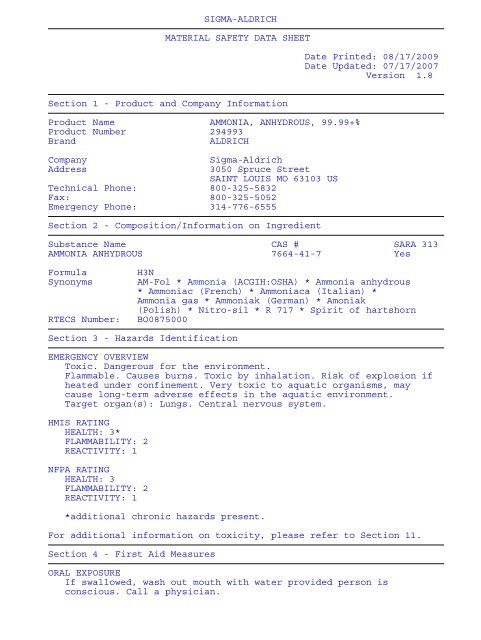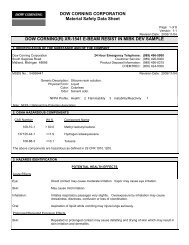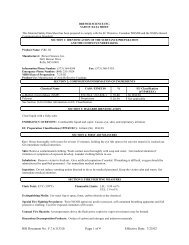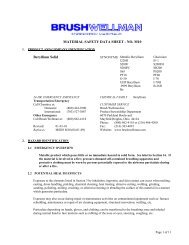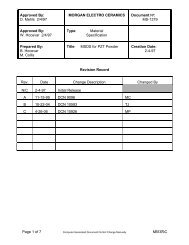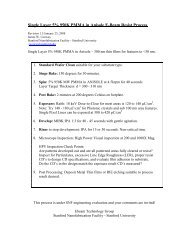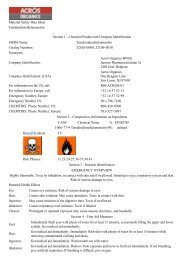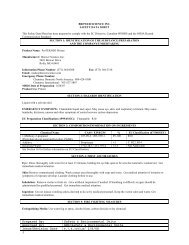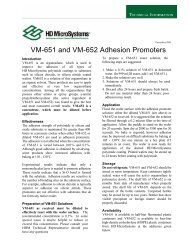SIGMA-ALDRICH MATERIAL SAFETY DATA SHEET Date Printed: 08/17/2009 ...
SIGMA-ALDRICH MATERIAL SAFETY DATA SHEET Date Printed: 08/17/2009 ...
SIGMA-ALDRICH MATERIAL SAFETY DATA SHEET Date Printed: 08/17/2009 ...
You also want an ePaper? Increase the reach of your titles
YUMPU automatically turns print PDFs into web optimized ePapers that Google loves.
<strong>SIGMA</strong>-<strong>ALDRICH</strong><br />
<strong>MATERIAL</strong> <strong>SAFETY</strong> <strong>DATA</strong> <strong>SHEET</strong><br />
Section 1 - Product and Company Information<br />
Product Name AMMONIA, ANHYDROUS, 99.99+%<br />
Product Number 294993<br />
Brand <strong>ALDRICH</strong><br />
Company Sigma-Aldrich<br />
Address 3050 Spruce Street<br />
SAINT LOUIS MO 63103 US<br />
Technical Phone: 800-325-5832<br />
Fax: 800-325-5052<br />
Emergency Phone: 314-776-6555<br />
Section 2 - Composition/Information on Ingredient<br />
<strong>Date</strong> <strong>Printed</strong>: <strong>08</strong>/<strong>17</strong>/<strong>2009</strong><br />
<strong>Date</strong> Updated: 07/<strong>17</strong>/2007<br />
Version 1.8<br />
Substance Name CAS # SARA 313<br />
AMMONIA ANHYDROUS 7664-41-7 Yes<br />
Formula H3N<br />
Synonyms AM-Fol * Ammonia (ACGIH:OSHA) * Ammonia anhydrous<br />
* Ammoniac (French) * Ammoniaca (Italian) *<br />
Ammonia gas * Ammoniak (German) * Amoniak<br />
(Polish) * Nitro-sil * R 7<strong>17</strong> * Spirit of hartshorn<br />
RTECS Number: BO<strong>08</strong>75000<br />
Section 3 - Hazards Identification<br />
EMERGENCY OVERVIEW<br />
Toxic. Dangerous for the environment.<br />
Flammable. Causes burns. Toxic by inhalation. Risk of explosion if<br />
heated under confinement. Very toxic to aquatic organisms, may<br />
cause long-term adverse effects in the aquatic environment.<br />
Target organ(s): Lungs. Central nervous system.<br />
HMIS RATING<br />
HEALTH: 3*<br />
FLAMMABILITY: 2<br />
REACTIVITY: 1<br />
NFPA RATING<br />
HEALTH: 3<br />
FLAMMABILITY: 2<br />
REACTIVITY: 1<br />
*additional chronic hazards present.<br />
For additional information on toxicity, please refer to Section 11.<br />
Section 4 - First Aid Measures<br />
ORAL EXPOSURE<br />
If swallowed, wash out mouth with water provided person is<br />
conscious. Call a physician.
INHALATION EXPOSURE<br />
If inhaled, remove to fresh air. If not breathing give<br />
artificial respiration. If breathing is difficult, give oxygen.<br />
DERMAL EXPOSURE<br />
In case of contact, immediately wash skin with soap and copious<br />
amounts of water.<br />
EYE EXPOSURE<br />
Contamination of the eyes should be treated by immediate and<br />
prolonged irrigation with copious amounts of water. Assure<br />
adequate flushing of the eyes by separating the eyelids with<br />
fingers.<br />
Section 5 - Fire Fighting Measures<br />
FLAMMABLE HAZARDS<br />
Flammable Hazards: Yes<br />
EXPLOSION HAZARDS<br />
May form explosive mixtures with air Container explosion may<br />
occur under fire conditions.<br />
FLASH POINT<br />
269.6 °F 132 °C Method: closed cup<br />
EXPLOSION LIMITS<br />
Lower: 15 % Upper: 25 %<br />
AUTOIGNITION TEMP<br />
651 °C<br />
FLAMMABILITY<br />
N/A<br />
EXTINGUISHING MEDIA<br />
Suitable: For small (incipient) fires, use media such as<br />
"alcohol" foam, dry chemical, or carbon dioxide. For large<br />
fires, apply water from as far as possible. Use very large<br />
quantities (flooding) of water applied as a mist or spray; solid<br />
streams of water may be ineffective. Cool all affected<br />
containers with flooding quantities of water.<br />
FIREFIGHTING<br />
Protective Equipment: Wear self-contained breathing apparatus<br />
and protective clothing to prevent contact with skin and eyes.<br />
Specific Hazard(s): Vapor may travel considerable distance to<br />
source of ignition and flash back. Emits toxic fumes under fire<br />
conditions. Flammable gas.<br />
Specific Method(s) of Fire Fighting: Do not extinguish burning<br />
gas if flow cannot be shut off immediately. Use water spray or<br />
fog nozzle to keep cylinder cool. Move cylinder away from fire<br />
if there is no risk.<br />
Section 6 - Accidental Release Measures<br />
PROCEDURE TO BE FOLLOWED IN CASE OF LEAK OR SPILL<br />
Evacuate area and keep personnel upwind. Shut off leak if there<br />
is no risk. Shut off all sources of ignition.<br />
PROCEDURE(S) OF PERSONAL PRECAUTION(S)<br />
<strong>ALDRICH</strong> - 294993 www.sigma-aldrich.com Page 2
Wear self-contained breathing apparatus, rubber boots, and heavy<br />
rubber gloves.<br />
METHODS FOR CLEANING UP<br />
Ventilate area and wash spill site after material pickup is<br />
complete.<br />
Section 7 - Handling and Storage<br />
HANDLING<br />
User Exposure: Do not breathe gas. Do not get in eyes, on skin,<br />
on clothing. Avoid prolonged or repeated exposure.<br />
STORAGE<br />
Suitable: Keep tightly closed. Use with equipment rated for<br />
cylinder pressure, and of compatible materials of construction.<br />
Close valve when not in use and when empty. Make sure cylinder<br />
is properly secured when in use or stored Cylinder temperature<br />
should not exceed 125°F (52°C).<br />
SPECIAL REQUIREMENTS<br />
Contents under pressure.<br />
Section 8 - Exposure Controls / PPE<br />
ENGINEERING CONTROLS<br />
Safety shower and eye bath. Warning: suck-back into cylinder may<br />
cause rupture. Use back-flow-preventive device in piping. Use only<br />
in a chemical fume hood.<br />
PERSONAL PROTECTIVE EQUIPMENT<br />
Respiratory: Use respirators and components tested and approved<br />
under appropriate government standards such as NIOSH (US) or CEN<br />
(EU). Where risk assessment shows air-purifying respirators are<br />
appropriate use a full-face respirator with multi-purpose<br />
combination (US) or type AXBEK - P3 (EN 14387) respirator<br />
cartridges as a backup to engineering controls. If the respirator<br />
is the sole means of protection, use a full-face supplied air<br />
respirator.<br />
Hand: Compatible chemical-resistant gloves.<br />
Eye: Chemical safety goggles.<br />
Other: Faceshield (8-inch minimum).<br />
GENERAL HYGIENE MEASURES<br />
Discard contaminated clothing and shoes. Wash thoroughly after<br />
handling.<br />
EXPOSURE LIMITS, RTECS<br />
Country Source Type Value<br />
USA ACGIH STEL 35 PPM<br />
USA ACGIH TWA 25 PPM<br />
USA MSHA Standard-air TWA 25 PPM (18 MG/M3)<br />
USA OSHA. PEL 8H TWA 50 PPM (35 MG/M3)<br />
New Zealand OEL<br />
Remarks: check ACGIH TLV<br />
USA NIOSH TWA 25 PPM<br />
STEL 35 PPM<br />
EXPOSURE LIMITS<br />
Country Source Type Value<br />
Poland NDS 14<br />
Poland NDSCh 28<br />
<strong>ALDRICH</strong> - 294993 www.sigma-aldrich.com Page 3
Poland NDSP -<br />
Section 9 - Physical/Chemical Properties<br />
Appearance Physical State: Gas<br />
Property Value At Temperature or Pressure<br />
Molecular Weight <strong>17</strong>.03 AMU<br />
pH N/A<br />
BP/BP Range - 33.0 °C 760 mmHg<br />
MP/MP Range - 78.0 °C<br />
Freezing Point - 77.7 °C<br />
Vapor Pressure 4802 mmHg 15.5 °C<br />
Vapor Density 0.6 g/l<br />
Saturated Vapor Conc. N/A<br />
SG/Density 0.59 g/cm3<br />
Bulk Density N/A<br />
Odor Threshold N/A<br />
Volatile% N/A<br />
VOC Content N/A<br />
Water Content < 0.03 %<br />
Solvent Content N/A<br />
Evaporation Rate N/A<br />
Viscosity N/A<br />
Surface Tension N/A<br />
Partition Coefficient N/A<br />
Decomposition Temp. N/A<br />
Flash Point 269.6 °F 132 °C Method: closed cup<br />
Explosion Limits Lower: 15 %<br />
Upper: 25 %<br />
Flammability N/A<br />
Autoignition Temp 651 °C<br />
Refractive Index N/A<br />
Optical Rotation N/A<br />
Miscellaneous Data N/A<br />
Solubility N/A<br />
Solubility in Water:Soluble.<br />
N/A = not available<br />
Section 10 - Stability and Reactivity<br />
STABILITY<br />
Stable: Stable.<br />
Conditions to Avoid: Tin. Moisture.<br />
Materials to Avoid: Oxidizing agents, Galvanized iron, Zinc,<br />
Copper, Silver/silver oxides, Cadmium/cadmium oxides, Alcohols,<br />
Acids, Halogens, Aldehydes.<br />
HAZARDOUS DECOMPOSITION PRODUCTS<br />
Hazardous Decomposition Products: Ammonia.<br />
HAZARDOUS POLYMERIZATION<br />
Hazardous Polymerization: Will not occur<br />
Section 11 - Toxicological Information<br />
ROUTE OF EXPOSURE<br />
Skin Contact: Causes burns.<br />
Skin Absorption: May be harmful if absorbed through the skin.<br />
Eye Contact: Causes burns.<br />
<strong>ALDRICH</strong> - 294993 www.sigma-aldrich.com Page 4
Inhalation: Can cause rapid suffocation. Toxic if inhaled.<br />
Material is extremely destructive to the tissue of the mucous<br />
membranes and upper respiratory tract.<br />
Ingestion: May be harmful if swallowed.<br />
TARGET ORGAN(S) OR SYSTEM(S)<br />
Lungs. Central nervous system. Liver. Kidneys.<br />
SIGNS AND SYMPTOMS OF EXPOSURE<br />
Material is extremely destructive to tissue of the mucous<br />
membranes and upper respiratory tract, eyes, and skin.<br />
Inhalation may result in spasm, inflammation and edema of the<br />
larynxand bronchi, chemical pneumonitis, and pulmonary edema.<br />
Symptoms of exposure may include burning sensation, coughing,<br />
wheezing, laryngitis, shortness of breath, headache, nausea, and<br />
vomiting. To the best of our knowledge, the chemical, physical,<br />
and toxicological properties have not been thoroughly<br />
investigated.<br />
TOXICITY <strong>DATA</strong><br />
Inhalation<br />
Rat<br />
7,338.0 - 11,590.0 ppm<br />
LC50<br />
Inhalation<br />
Rat<br />
2,000 ppm<br />
LC50<br />
Inhalation<br />
Human<br />
5,000 ppm<br />
LCLO<br />
Inhalation<br />
Rat<br />
2,000 ppm<br />
LC50<br />
Inhalation<br />
Mouse<br />
4,230 ppm<br />
LC50<br />
Remarks: Behavioral:Ataxia. Behavioral:Tremor.<br />
Behavioral:Convulsions or effect on seizure threshold.<br />
Inhalation<br />
Cat<br />
7,000 mg/m3<br />
LC50<br />
Remarks: Peripheral Nerve and Sensation:Flaccid paralysis<br />
without anesthesia (usually neuromuscular blockage).<br />
Behavioral:Excitement.<br />
Inhalation<br />
Rabbit<br />
7,000 mg/m3<br />
LC50<br />
Remarks: Peripheral Nerve and Sensation:Flaccid paralysis<br />
without anesthesia (usually neuromuscular blockage).<br />
Behavioral:Excitement.<br />
<strong>ALDRICH</strong> - 294993 www.sigma-aldrich.com Page 5
CHRONIC EXPOSURE - CARCINOGEN<br />
Species: Rat<br />
Route of Application: Oral<br />
Dose: 1680 MG/KG<br />
Exposure Time: 24W<br />
Frequency: C<br />
Result: Tumorigenic:Carcinogenic by RTECS criteria.<br />
Gastrointestinal:Tumors.<br />
CHRONIC EXPOSURE - MUTAGEN<br />
Species: Rat<br />
Route: Inhalation<br />
Dose: 19800 UG/M3/16W<br />
Mutation test: Cytogenetic analysis<br />
Section 12 - Ecological Information<br />
No data available.<br />
Section 13 - Disposal Considerations<br />
APPROPRIATE METHOD OF DISPOSAL OF SUBSTANCE OR PREPARATION<br />
Contact a licensed professional waste disposal service to dispose<br />
of this material. Observe all federal, state, and local<br />
environmental regulations.<br />
APPROPRIATE METHOD OF DISPOSAL OF CONTAMINATED PACKAGING<br />
Caution: no-return cylinder. Do not reuse. Empty cylinder will<br />
contain hazardous residue. Follow proper disposal techniques.<br />
Section 14 - Transport Information<br />
DOT<br />
Proper Shipping Name: Ammonia, anhydrous<br />
UN#: 1005<br />
Class: 2.2<br />
Packing Group: None<br />
Hazard Label: Poison inhalation hazard<br />
Hazard Label: Non-Flammable gas<br />
PIH: Zone D<br />
IATA<br />
Proper Shipping Name: Ammonia, anhydrous<br />
IATA UN Number: 1005<br />
Hazard Class: 2.3<br />
Not Allowed - Aircraft: Cargo aircraft only. Not<br />
permitted on passenger aircraft.<br />
Section 15 - Regulatory Information<br />
EU DIRECTIVES CLASSIFICATION<br />
Symbol of Danger: T-N<br />
Indication of Danger: Toxic. Dangerous for the environment.<br />
R: 10-23-34-50<br />
Risk Statements: Flammable. Toxic by inhalation. Causes burns.<br />
Very toxic to aquatic organisms.<br />
S: 9-16-26-36/37/39-45-61<br />
Safety Statements: Keep container in a well-ventilated place.<br />
Keep away from sources of ignition - no smoking. In case of<br />
contact with eyes, rinse immediately with plenty of water and<br />
seek medical advice. Wear suitable protective clothing, gloves,<br />
<strong>ALDRICH</strong> - 294993 www.sigma-aldrich.com Page 6
and eye/face protection. In case of accident or if you feel<br />
unwell, seek medical advice immediately (show the label where<br />
possible). Avoid release to the environment. Refer to special<br />
instructions/safety data sheets.<br />
US CLASSIFICATION AND LABEL TEXT<br />
Indication of Danger: Toxic. Dangerous for the environment.<br />
Risk Statements: Flammable. Causes burns. Toxic by inhalation.<br />
Risk of explosion if heated under confinement. Very toxic to<br />
aquatic organisms, may cause long-term adverse effects in the<br />
aquatic environment.<br />
Safety Statements: Keep container in a well-ventilated place.<br />
Keep away from sources of ignition - no smoking. In case of<br />
contact with eyes, rinse immediately with plenty of water and<br />
seek medical advice. Wear suitable protective clothing, gloves,<br />
and eye/face protection. In case of accident or if you feel<br />
unwell, seek medical advice immediately (show the label where<br />
possible). Avoid release to the environment. Refer to special<br />
instructions/safety data sheets.<br />
US Statements: Target organ(s): Lungs. Central nervous system.<br />
UNITED STATES REGULATORY INFORMATION<br />
SARA LISTED: Yes<br />
DEMINIMIS: 1 %<br />
NOTES: This product is subject to SARA section 313 reporting<br />
requirements.<br />
TSCA INVENTORY ITEM: Yes<br />
CANADA REGULATORY INFORMATION<br />
WHMIS Classification: This product has been classified in<br />
accordance with the hazard criteria of the CPR, and the MSDS<br />
contains all the information required by the CPR.<br />
DSL: Yes<br />
NDSL: No<br />
Section 16 - Other Information<br />
DISCLAIMER<br />
For R&D use only. Not for drug, household or other uses.<br />
WARRANTY<br />
The above information is believed to be correct but does not<br />
purport to be all inclusive and shall be used only as a guide. The<br />
information in this document is based on the present state of our<br />
knowledge and is applicable to the product with regard to<br />
appropriate safety precautions. It does not represent any<br />
guarantee of the properties of the product. Sigma-Aldrich Inc.,<br />
shall not be held liable for any damage resulting from handling or<br />
from contact with the above product. See reverse side of invoice<br />
or packing slip for additional terms and conditions of sale.<br />
Copyright <strong>2009</strong> Sigma-Aldrich Co. License granted to make unlimited<br />
paper copies for internal use only.<br />
<strong>ALDRICH</strong> - 294993 www.sigma-aldrich.com Page 7


